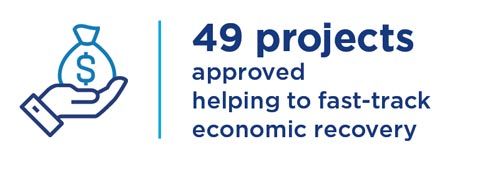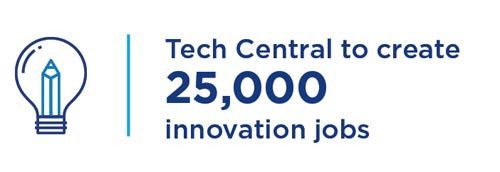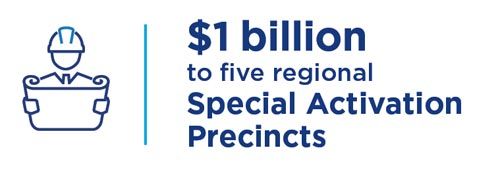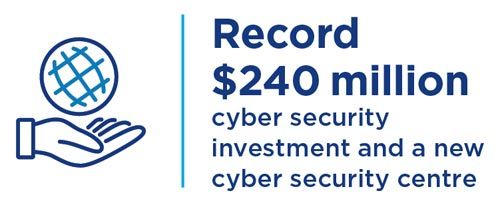COVID-19 recovery plan
How we will remain resilient and build a future-proof economy

2020 has been a challenging year for NSW and the nation, with bushfires, the ongoing drought and now COVID-19.
In the midst of the pandemic and the host of measures and restrictions it requires, we are only just beginning to face its economic consequences. But rather than just repairing our economy, now is the time to ensure we rebuild it to be even more resilient and self-sufficient.
We have an opportunity to harness the innovations and lessons learnt during the COVID-19 pandemic – in areas such as advanced manufacturing, digitisation and reforming federal and state relations.
This
File
COVID-19 Recovery Plan (PDF 2.7MB)details how the NSW Government will ensure we remain resilient and build a future-proof economy.
Premier of New South Wales
- How we will remain resilient and build a future-proof economy
- 1. Infrastructure pipeline – an area of demonstrated global leadership
- 2. Planning and precincts – growing world-leading industries
- 3. Education and skills – equipping our students for the jobs of the future
- 4. Digitisation – accelerating recovery
- 5. Advanced manufacturing and local supply chains – building a self-sufficient economy
- 6. Federal-state relations – the time is now for national reform
- Download the plan
1. Infrastructure pipeline – an area of demonstrated global leadership
The NSW Government is committing to a guaranteed $100 billion infrastructure pipeline over four years to drive employment growth and help create 88,000 direct jobs. This includes a $3 billion accelerator fund.
To put this record investment into perspective, the Federal Government has committed $100 billion over 10 years to transport infrastructure across Australia, while the Victorian and Queensland governments have $56 billion and $52 billion infrastructure pipelines being rolled out over four years. This past financial year our state budgeted to spend $23.7 billion on infrastructure, which is more than places such as Hong Kong ($18.6 billion) and Singapore ($19.6 billion).
NSW is a global leader in the way its infrastructure projects are structured. This has included reviewing and accepting many unsolicited proposals from the private sector since 2012, leading to the construction of NorthConnex and the Wynyard Place upgrade. Asset recycling has played a role in funding some of the biggest projects in the state including WestConnex and the Sydney Metro City and Southwest Project.
The NSW Government has also invested record amounts towards regional infrastructure including the Pacific Highway upgrade, the South Australia-NSW interconnector and the construction of the first new dam in NSW in more than 30 years.
Infrastructure NSW was created to oversee all major projects. It provides independent advice and transparency, encouraging early participation from industry in each project’s design, construction, management and operation.
Overall, the NSW Government’s record infrastructure investment will bring many economic benefits, including job creation and a 0.5 percentage point p.a. contribution to economic growth over the next two years.*
* Source: Half-year Budget Review



2. Planning and precincts – growing world-leading industries
Our Planning System Acceleration Program brings forward immediate reforms to support productivity, investment and jobs during COVID-19 with a Delivery Unit focused on unblocking programs caught up in the system.
So far, 49 projects have been approved, including the Snowy 2.0 Main Works, Mt Druitt CBD amendment, Sydney Fish Market redevelopment and Tweed Valley Hospital Stage 2.
Our latest planning reforms, announced on 15 July, will reduce the time taken to approve projects. This will allow:
- rezoning decisions to be cut by 191 days (33% time saving)
- decisions on development applications for larger projects in regional areas to be cut by 91 days (25% time saving)
- decisions on major projects of state significance to be cut by 20 days (17% time saving).
ePlanning, the online platform that allows homeowners and businesses to lodge their development applications, will receive a statewide rollout by mid-2021. Currently, it is being used by 48 out of 128 councils, with 19 onboarded during COVID-19. As a result, councils have reduced application processing times by up to 73%, helping to stimulate construction and the local economy.
Our precincts, which incorporate industries such as technology, defence, food and agribusiness, are attracting investment from businesses across the world.
Sydney’s Tech Central, a world-class technology and innovation precinct, will create 25,000 innovation jobs and host start-ups, scale-ups and innovation partners. Atlassian has committed to becoming an anchor tenant, creating 4000 local Atlassian research and product development jobs while helping Tech Central become the biggest technology hub of its kind in Australia.
The Western Sydney Aerotropolis will further boost our innovation credentials. The CSIRO is planning for up to 450 of its researchers and other staff to be based in a new state-of-the-art facility at the Aerotropolis.
Meanwhile, we have committed $1 billion to five regional Special Activation Precincts in Parkes, Wagga Wagga, Moree, Williamtown and the Snowy Mountains, to attract new investment and create thousands of new jobs in regional NSW.



3. Education and skills – equipping our students for the jobs of the future
NSW is currently overhauling its school curriculum in its biggest shake-up in 30 years. The curriculum review is now more important than ever as the state shifts to economic recovery.
While NSW has invested record amounts on building new schools and resources for teachers, it is clear changes need to be made to improve standards.
This will involve decluttering the curriculum, with a renewed focus on the core competencies of English, maths and science. There will also be clearer pathways to both university study and vocational training, ensuring that subjects combine knowledge with hands-on application.
Changes to the curriculum will start in 2021 and all years from kindergarten to year 12 will be learning from the new curriculum by 2024.
Meanwhile, communities across the state are being supported with a historic $6.7 billion investment to deliver more than 190 new and upgraded schools. It will provide the best possible learning environment to ensure students are equipped with the skills they need to succeed.
A review of TAFE and the Vocational Education and Training (VET) sector is also underway. This will help us respond to skills shortages in areas such as automotive and engineering, construction and health trades, and to skill workers in the emerging industries of the future. There will be a push for greater industry involvement in co-designing courses with public education providers, modelling successful initiatives in Germany, the United States and the United Kingdom.
By undertaking this review and modernising our TAFE and VET systems, we can ensure they remain nationally and internationally competitive, and a desirable option for school leavers.

4. Digitisation – accelerating recovery
NSW is already the national leader in digital maturity in government, but our ambition is to lead the world.
The pandemic is highlighting just how much the quality of interactions with government matters. Our goal is to make sure these are seamless, easy and customer friendly.
We are committed to revolutionising the way citizens interact with government by adopting innovative digital models and shared services, and replacing cumbersome manual processes. Already the NSW Digital Driver Licence has had a 28% uptake (or 1.6 million drivers). And we’re helping people access better deals through online services such as FuelCheck and Energy Switch.
Telehealth services received a major boost during the pandemic. Patients and clinicians embraced the service with a 700% increase in February to May 2020 compared with the same period last year. This rapid expansion allowed patients to be cared for in their own homes, which is more convenient for patients and reduces pressure on acute services. This success will be built upon with further rollouts planned across the state.
We’re using digital and data to improve our services in a number of other ways, such as the Spatial Digital Twin project, which is upgrading existing 2D spatial maps to create digital real-world models of our cities and communities. This will allow better planning, design and modelling for the state’s future needs, including infrastructure.
The NSW Government has also invested $1.6 billion in the Digital Restart Fund to help us provide more digital services and improve customer service. The funding includes $240 million to boost cyber security and establish the Cyber Security Management Centre in Bathurst.

5. Advanced manufacturing and local supply chains – building a self-sufficient economy
The onset of the COVID-19 pandemic revealed the importance of a local manufacturing supply chain and highlighted some of the state’s unrealised industry capabilities.
Following a NSW Government call to arms, 1950 businesses offered to retool in response to the pandemic, with liquor manufacturers adapting their operations to produce hand sanitiser, and NSW Health partnering with universities and industry to develop prototype ventilator solutions.
NSW manufacturers are increasingly using new technology or employing advanced business models that allow them to compete based on value. This includes adopting business models that offer opportunities to lower production costs while delivering high-value manufacturing solutions. Advanced manufacturers in NSW provide the most valuable and skill-intensive parts of the production process, including high-tech design and development, innovative research, product customisation, client-focused support and repair services.
Advanced manufacturing leaders who call NSW home include:
- Blueprint Lab, St Peters, one of the few Australian companies designing and building advanced robotics, creating robotic arms for underwater vehicles as well as underwater lights and cameras
- Inventia Life Science, Alexandria, which produces 3D bioprinting equipment to create 3D cell models for medical research
- Omni Tanker, Smeaton Grange, which manufactures road tanker equipment to transport and store dangerous liquids and gases
- Cochlear, headquartered at Macquarie University, which has made more than 550,000 implantable devices to help people hear, and has two Sydney manufacturing sites.
With a collaborative research and development centre at the core of the new Western Sydney Aerotropolis, the NSW Government is positioning Western Sydney to become the national capital for advanced manufacturing. Many cutting-edge businesses are setting up in the area, including Mitsubishi Heavy Industries, Hitachi and Northrop Grumman. Amazon has announced it will develop a new advanced storage and distribution centre in Western Sydney, incorporating the company’s latest robotics systems. All of this investment will help attract top talent to the area, driving economic development and job creation.

6. Federal-state relations – the time is now for national reform
The Council of Australian Governments (COAG) was an important vehicle when it was established in 1992 but we need a new, dynamic way to manage federal–state relations.
COVID-19 has demonstrated our ability to strip out the unnecessary bureaucratic processes, duplication and red tape that have slowed down national reform to date.
National Cabinet, used during the COVID-19 pandemic, has proven it can get things done, making rapid and critical decisions on national health and economic responses to the pandemic.
With National Cabinet set to replace COAG, now is the time to continue the reform path and tackle other crossjurisdictional areas – such as improving our taxation system and exploring opportunities for asset recycling, deregulation and service innovation.